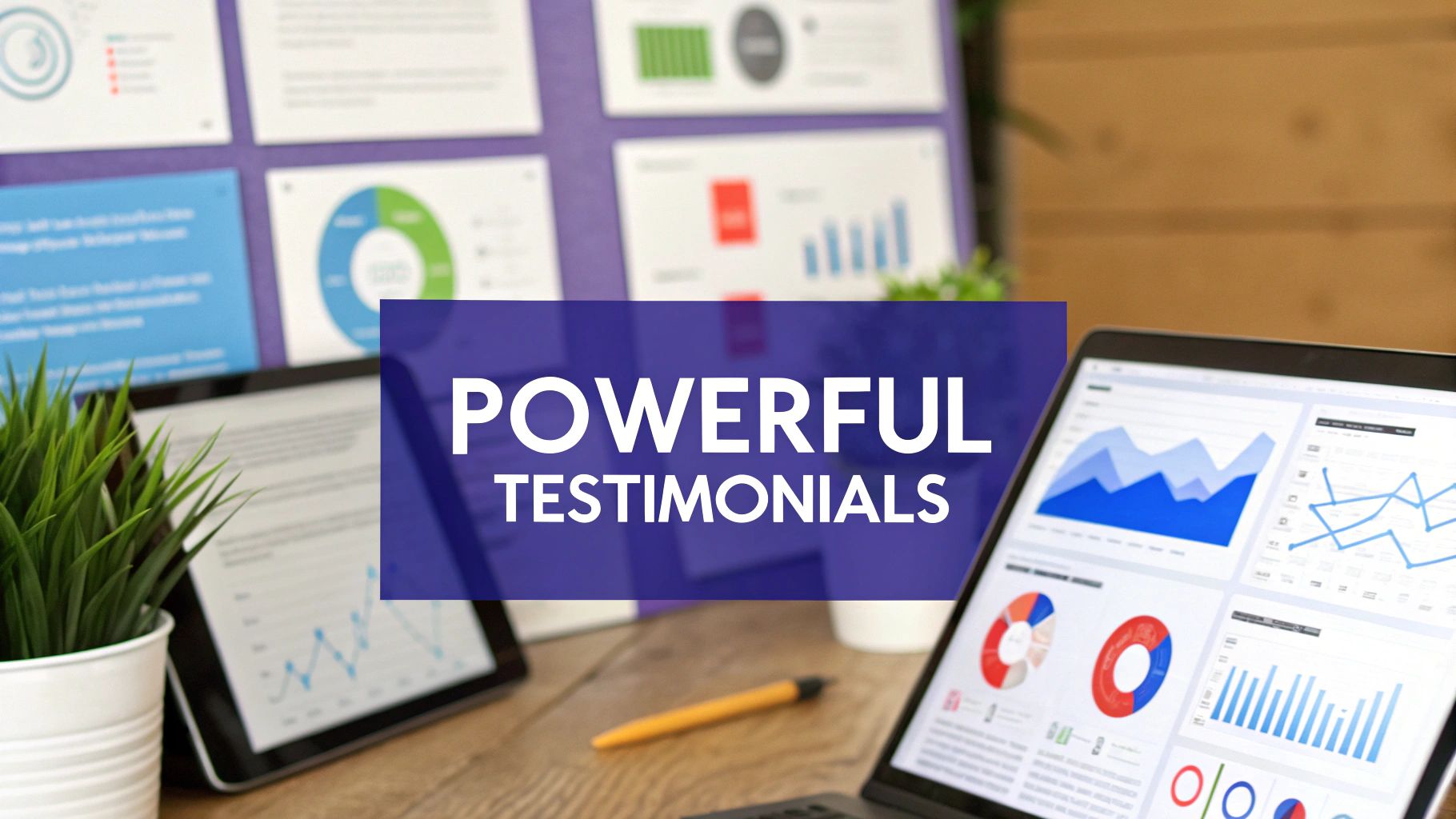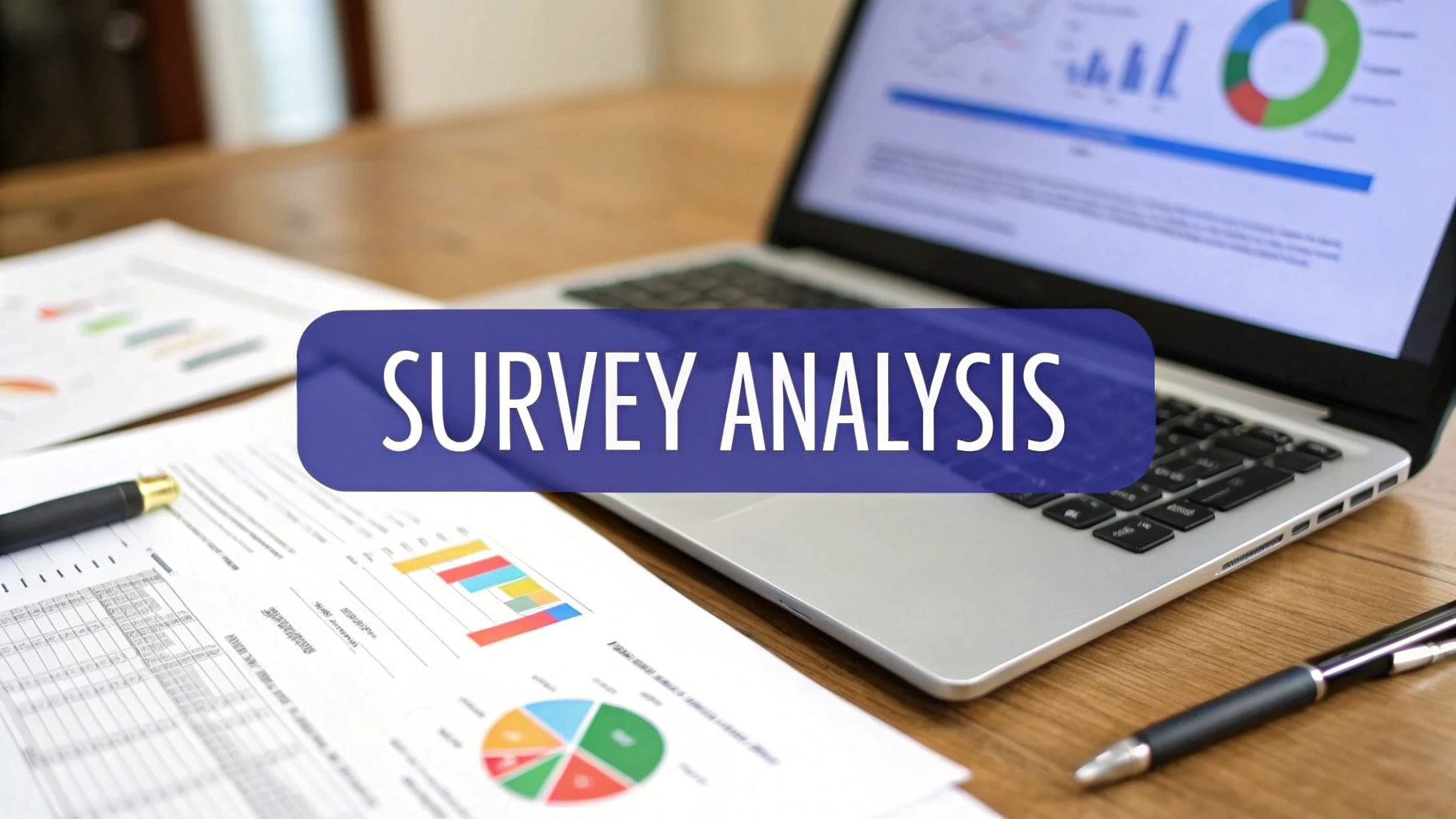8 Great Voice of the Customer Example Types for 2025
Discover how to capture customer insights with a real voice of the customer example. See 8 types of feedback from testimonials to NPS and support tickets.

Are you trying to figure out what your customers really think? Knowing how to collect and understand customer feedback is key to improving your product and keeping people happy. Many companies gather feedback, but only some know how to turn those comments into real improvements. It starts with recognizing the different ways customers communicate, from direct reviews to how they use your product every day. The feedback you collect is the foundation of a strong Voice of the Customer program.
This article provides a practical look at the voice of the customer example in action. We will show you 8 specific types of customer feedback that successful companies use. For each one, we'll break down a real-world scenario, showing exactly how businesses translate raw customer input into strategic decisions and product improvements.
You will see concrete examples from:
- Customer testimonials and support tickets
- Net Promoter Score (NPS) surveys
- Public review platforms
- In-depth customer interviews
- Social media conversations
Instead of just theory, you'll get clear, actionable steps for collecting this feedback and putting it to work for your own business. Let's look at how to find and use your customers' real voice.
1. Direct Customer Testimonials
Direct customer testimonials are one of the most powerful and authentic forms of Voice of the Customer (VoC) feedback. These are firsthand accounts from users detailing their experiences, satisfaction, and the specific value they've gained from a product or service. Unlike aggregated data, testimonials capture genuine emotion and real-world context, making them a potent tool for marketing, product development, and building social proof.

Strategic Analysis
The strength of a direct testimonial lies in its specificity and credibility. A vague compliment like "great product" has little impact. However, a specific, quantifiable outcome like Slack's customer claim of reducing "internal emails by 40%" provides concrete evidence of value. This type of voice of the customer example directly addresses a common pain point (email overload) with a measurable solution.
Including the customer's name, title, and company adds a layer of authenticity that anonymous reviews lack. This makes the feedback more trustworthy to prospective buyers who see themselves in the person providing the quote.
Actionable Takeaways
To effectively collect and leverage testimonials, product and marketing teams should implement a proactive strategy.
- Capture feedback at peak moments: The best time to ask for a testimonial is immediately after a customer has achieved a success or expressed high satisfaction, such as after a positive support interaction or a successful project launch.
- Ask for specific, quantifiable results: Instead of asking "Do you like our product?", ask "What specific metric has improved since you started using our product?". Guide customers to provide data-driven insights. For more ideas on how to structure your requests, you can find helpful tips in this guide to creating a client testimonials template.
- Leverage video: A video testimonial can be more compelling than text. It adds a human element and allows potential customers to see and hear the genuine satisfaction of an existing user.
- Showcase stories with context: Organize your feedback into relatable narratives. For further inspiration on how to leverage positive feedback, you can explore a broader collection of customer stories to see how others structure their examples.
2. Customer Support Tickets and Issues
Customer support tickets are the raw, unfiltered voice of the customer captured in real-time. These documented complaints, questions, and issues logged through channels like email, chat, and ticketing systems reveal genuine pain points, product gaps, and usability problems. This form of feedback comes directly from users encountering friction, making it a valuable resource for finding out where a product or service falls short of expectations.

Strategic Analysis
The strategic value of support tickets lies in their volume and specificity. Analyzing trends across thousands of tickets can uncover systemic issues that individual feedback might miss. For example, Airbnb identified significant safety and trust concerns by analyzing customer support issues, which directly led to the creation of its Host Guarantee program. This initiative addressed a core user fear and became a key differentiator.
Similarly, Microsoft's analysis of support tickets revealed widespread frustration with its Windows update process. This voice of the customer example directly informed significant UI and process redesigns to create a more user-friendly experience. The data provides a clear, evidence-based roadmap for high-impact product improvements.
Actionable Takeaways
To transform raw support data into a strategic asset, organizations need a systematic approach. Product and customer success teams should collaborate to extract meaningful patterns.
- Implement a robust tagging system: Create and consistently apply tags to categorize tickets by feature, problem type (e.g., bug, usability, feature request), and customer sentiment. This organizes the data for easier analysis.
- Conduct regular ticket audits: Dedicate time each month or quarter to review tickets for recurring themes. Share anonymized summaries and direct quotes with product and engineering teams to keep them connected to the user experience.
- Track key support metrics: Monitor metrics like resolution time, first-contact resolution, and post-interaction customer satisfaction (CSAT) scores. A dip in these numbers can be an early indicator of a larger product issue.
- Use sentiment analysis tools: Employ AI-powered tools to scan ticket text and identify customers who are particularly frustrated or at risk of churning. This allows for proactive intervention and escalation.
3. Net Promoter Score (NPS) Feedback
Net Promoter Score (NPS) feedback moves beyond a simple numerical rating to uncover the "why" behind customer loyalty. This voice of the customer example pairs the standard question, "How likely are you to recommend us to a friend or colleague?" with an open-ended follow-up. The qualitative responses to "Why did you give that score?" provide rich, contextual insights into the specific drivers of satisfaction or dissatisfaction.
Strategic Analysis
The power of NPS feedback lies in its ability to segment customers into Promoters, Passives, and Detractors and then analyze their distinct experiences. For example, Southwest Airlines uses detractor feedback to identify and address systemic issues like baggage handling processes or flight delays. This targeted approach allows them to prioritize improvements that have the greatest impact on customer sentiment.
Similarly, Zoom's rapid response to security concerns raised in their NPS feedback helped them rebuild trust and improve their score. This shows how NPS is a continuous improvement loop. Analyzing the reasoning behind the scores provides a clear roadmap for product development and service improvements.
Actionable Takeaways
To transform NPS from a simple score into an actionable feedback system, teams should adopt a structured process for analysis and response.
- Ask "Why" Immediately: Capture the customer's reasoning at the moment they provide their score. This immediate follow-up makes sure the feedback is fresh, specific, and directly linked to their rating.
- Segment Your Feedback: Analyze responses based on customer segments, such as SMB versus Enterprise, or by user persona. This helps identify issues that disproportionately affect high-value or strategic customer groups.
- Establish a Review Cadence: Create a weekly or bi-weekly ritual for the product and customer success teams to review detractor feedback. This practice helps identify urgent problems and emerging trends before they escalate.
- Close the Loop: Actively communicate with customers about the changes you've made based on their feedback. This shows you are listening and reinforces their willingness to provide input in the future. To get started, you can explore best practices for creating effective NPS surveys.
4. Customer Review Platforms (App Stores, Google Reviews, Trustpilot)
Customer review platforms are public, third-party channels where users openly share their experiences with a product or service. Sites like Trustpilot, G2, Capterra, and app store review sections are unfiltered sources of the Voice of the Customer (VoC). This feedback is highly influential because it is uncontrolled by the brand, capturing authentic sentiment that carries significant social proof.
Strategic Analysis
The power of public review platforms comes from their transparency and scale. A single critical review detailing a safety concern on Uber's Trustpilot page holds more weight than internal feedback because it's visible to millions of potential customers. This uncontrolled environment forces companies to address issues directly and publicly, turning a potential crisis into a demonstration of customer commitment.
This form of voice of the customer example provides a real-time pulse on market perception. Duolingo, for instance, actively monitors App Store reviews for bug reports, feature requests, and user frustrations. This direct line to their user base allows them to maintain high ratings by demonstrating responsiveness and community engagement, making users feel heard and valued.
Actionable Takeaways
To effectively manage and learn from public review platforms, teams need a structured and responsive approach.
- Monitor feedback in real time: Use alerts and aggregation tools to track reviews across all relevant platforms daily. A swift response shows that you are listening and care about the customer experience.
- Respond to all feedback: Develop a strategy to reply to both positive and negative reviews within 24 hours. Thanking happy customers and publicly resolving issues for unhappy ones can turn detractors into advocates.
- Analyze trends in negative reviews: Systematically categorize 1- and 2-star reviews to identify recurring pain points. These patterns are goldmines for pinpointing critical product flaws and service gaps that need immediate attention. You can find more strategies for handling reviews on Google and other platforms.
- Use insights to inform your roadmap: Integrate key themes from public reviews directly into your product development cycle. If users consistently request a feature or complain about a workflow, prioritize it in your next sprint.
5. Customer Interview Transcripts
Customer interview transcripts are detailed, word-for-word records of conversations between a company and its customers. These interviews, often led by user researchers or product managers, go beyond surface-level data to uncover the "why" behind user behavior. They reveal the specific motivations, pain points, and workflows that quantitative metrics alone cannot capture, providing a rich qualitative voice of the customer example.

Strategic Analysis
The strategic value of transcripts comes from their raw, unfiltered nature. For instance, when the founders of Airbnb interviewed early hosts, they heard that hosts wanted more bookings. The transcripts revealed a deep-seated fear of property damage, a powerful emotional barrier that surveys might have missed. This specific insight led directly to the creation of the transformative Host Guarantee program, which addressed the core anxiety and unlocked massive growth.
By analyzing the specific language, pauses, and emotional tone within a transcript, teams can identify latent needs and unspoken frustrations. This qualitative depth provides context for quantitative data, helping teams build solutions that resonate on a human level rather than just a functional one.
Actionable Takeaways
To maximize the value of customer interviews, teams must be systematic in their approach to both conducting and analyzing them.
- Ask open-ended, non-leading questions: Instead of asking, "Wouldn't this feature make your job easier?" ask, "Walk me through how you currently handle this task." This encourages detailed stories over simple yes/no answers.
- Use the '5 Whys' technique: When a customer mentions a problem, ask "Why?" repeatedly to drill down to the root cause of their motivation or frustration. This method helps uncover foundational insights.
- Transcribe and thematically code interviews: Recording and transcribing interviews (with permission) is vital for accurate analysis. To streamline the process of converting spoken customer insights into actionable text, consider exploring the best interview transcription software options. Grouping verbatim quotes into themes helps identify recurring patterns and priorities.
- Share impactful highlight reels: Create short video or audio clips of key "aha!" moments from your interviews. Sharing these with the wider organization, including engineers and executives, builds empathy and aligns everyone around the customer's true voice.
6. Social media Comments and Mentions
Social media platforms are vast, unfiltered sources of Voice of the Customer (VoC) feedback. Comments and brand mentions on sites like Twitter, Reddit, and LinkedIn represent organic conversations where customers voluntarily share their experiences. This real-time feedback provides a raw, immediate look into public sentiment, emerging issues, and authentic customer opinions.
Strategic Analysis
The power of social media as a voice of the customer example lies in its public and spontaneous nature. These mentions show what customers truly think and say to their peers. For instance, when Tesla customers on Twitter provide direct feedback to Elon Musk about software features, it often leads to rapid, visible product updates. This public interaction not only solves a user's problem but also shows the company's commitment to listening.
Similarly, brands like Wendy's use witty engagement on Twitter to build a loyal community. By responding to both positive and negative comments with a distinct brand voice, they turn simple mentions into powerful brand-building opportunities. Monitoring these channels reveals customer priorities and pain points before they escalate.
Actionable Takeaways
To effectively harness social media for VoC insights, teams need a structured approach to listening and engagement.
- Establish real-time monitoring: Use social listening tools like Sprout Social or Brandwatch to set up alerts for your brand name, products, and relevant keywords. This allows for immediate awareness of conversations as they happen.
- Respond with speed and authenticity: Aim to address customer complaints or questions quickly, ideally within an hour. Avoid generic corporate responses and engage with a genuine, human tone that reflects your brand's personality.
- Analyze sentiment trends: Don't just respond to individual comments. Aggregate the data weekly or monthly to identify overarching trends in customer sentiment, common feature requests, and recurring complaints.
- Identify and nurture brand advocates: When you find customers praising your brand, engage with them directly. These organic advocates can become powerful partners for testimonials, case studies, or user-generated content campaigns.
7. Customer Advisory Board Feedback
Customer Advisory Boards (CABs) are a highly strategic form of Voice of the Customer (VoC) feedback. A CAB is a curated group of key customers who meet regularly, often quarterly, to provide high-level guidance on a company's product roadmap, market strategy, and overall direction. Unlike broad surveys, CABs offer an in-depth, conversational forum for collecting forward-looking insights from a company's most important user segments.
Strategic Analysis
The power of a CAB comes from its focus on partnership rather than simple feedback collection. Companies like Salesforce use advisory boards to co-create their product roadmaps, getting direct input on major initiatives like the Einstein AI platform. This voice of the customer example moves beyond reactive problem-solving and allows a company to proactively validate its long-term vision with the people who matter most.
By assembling a diverse group of 8 to 12 customers from different industries and company sizes, a business can get a representative sample of its market. This structured dialogue helps uncover unmet needs and strategic opportunities that would be missed by other VoC methods. The insights are qualitative, deep, and contextual.
Actionable Takeaways
To build and run an effective Customer Advisory Board, product and leadership teams need a structured approach.
- Select members strategically: Choose influential customers who represent key market segments and are willing to provide candid, constructive feedback. Make sure there is diversity in company size, industry, and product usage.
- Establish a clear agenda and cadence: Schedule meetings quarterly or semi-annually with a consistent agenda. This allows members to prepare and keeps discussions focused on strategic topics like future roadmaps and market trends.
- Close the feedback loop: After each meeting, summarize the key takeaways and communicate back to the board how their input is influencing decisions. This shows that their participation is valued and has a real impact.
- Provide exclusive value: Incentivize participation by offering board members exclusive perks. Granting early access to new features, special discounts, or direct access to executives makes membership a prestigious and valuable opportunity.
8. Customer Success/Outcome Metrics and Behavioral Data
Customer success and behavioral data provide a quantitative look at the Voice of the Customer (VoC). This approach moves beyond what customers say and focuses on what they do. By analyzing feature adoption, usage patterns, and key outcomes, companies gain an objective view of where users find value and where they encounter friction. This data is the foundation of a proactive strategy to improve user experience and drive retention.
Strategic Analysis
The power of behavioral data lies in its ability to predict future outcomes. For instance, a SaaS company like HubSpot can track which features correlate with long-term retention. If data shows that customers who adopt its marketing automation tools are 50% less likely to churn, this becomes a critical insight. This voice of the customer example allows the customer success team to focus its efforts on driving adoption of that specific feature.
This data-driven approach allows for precise segmentation. By analyzing usage patterns across different customer personas or industries, businesses can identify specific needs and tailor their onboarding and support. A low survey completion rate in SurveyMonkey for a particular user segment might reveal a usability issue or a lack of relevant templates for that group, providing a clear path for product improvement.
Actionable Takeaways
To effectively use behavioral data, product and customer success teams need a structured system for tracking and interpretation.
- Track leading indicators: Focus on proactive metrics like feature adoption and user engagement, not just lagging metrics like churn. These early signals give you a chance to intervene before a customer is at risk.
- Create a customer health score: Combine multiple data points (loggins, feature usage, support tickets) into a single score. This provides a quick, at-a-glance view of account health and helps prioritize outreach.
- Set up automated alerts: Configure systems to notify your team of concerning usage patterns, like a sudden drop in activity. This enables a rapid, targeted response to potential issues.
- Combine with qualitative feedback: Use quantitative data to identify what is happening and qualitative feedback (like surveys or interviews) to find out why. This combination provides a complete picture for making informed decisions.
Voice of the Customer: 8-Source Comparison
Putting Customer Feedback into Action
Throughout this article, we have explored a wide range of powerful voice of the customer examples. From the direct praise in testimonials to the unfiltered honesty of social media mentions, each source offers a unique window into your customer's experience. We have seen how analyzing customer support tickets reveals immediate product friction points and how Net Promoter Score feedback can signal future growth or churn.
The key takeaway is that customer feedback is a rich, multifaceted collection of data points. When combined, this information creates a complete picture of customer perception and product performance. The examples from app store reviews, customer interviews, and advisory boards show the value of both quantitative and qualitative insights.
Your Next Steps: Building a VoC System
Seeing these different examples of customer feedback shows there is a lot of information available. The next step is to build a system to collect and use it. You do not need to tackle all eight types at once. The most effective approach is to start small and build momentum.
Here is a simple, actionable plan to get started:
- Choose Your Starting Point: Select one or two feedback channels that are most relevant to your business right now. For a SaaS company, analyzing support tickets for common problems or sending a simple NPS survey are excellent starting points.
- Establish a Collection Method: Implement a consistent process for gathering this feedback. This could involve setting up automated surveys, creating a dedicated Slack channel for customer-facing teams to share insights, or scheduling regular customer interviews.
- Analyze and Categorize: Don't let feedback sit in a spreadsheet. Regularly review the data, tag common themes, and identify recurring issues or requests. This analysis turns raw data into actionable intelligence.
- Close the Loop: Share what you have learned with the relevant teams, such as product, marketing, or engineering. More importantly, when you make a change based on feedback, let your customers know they were heard.
Mastering this process is about building a customer-centric culture. By consistently listening to what your customers say and what they do, you can make smarter choices that improve your product and build a more loyal user base. Each voice of the customer example is an opportunity to strengthen your business from the inside out, leading to higher retention, stronger brand affinity, and sustainable growth.
Ready to turn customer feedback into your biggest growth driver? Surva.ai helps you automatically collect, analyze, and act on customer insights from surveys, cancellation flows, and website widgets. Start building a product your customers love by visiting Surva.ai to see how it works.


